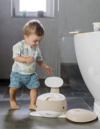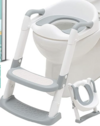Helping your child potty train: advice from your osteopath
Potty training is an important stage in your child's development. It's a time when he learns to manage his needs and become more independent. As parents, you play an essential role in this process, and your osteopath can also provide valuable advice on how best to support your child. In this article, we'll explore aspects of potty training and how osteopathy can contribute to this transition.
Cleanliness: a key stage in development
Potty training is a gradual process for children, and it's important to remember that each child evolves at his or her own pace. It can be an exciting time, but it can also be a frustrating one for parents. Patience and positive support are essential throughout this process.
Signs that your child is ready to begin potty training may vary, but some common signs include:
- The ability to stay dry for longer periods.
- Expressing an interest in the toilet or baby's diaper.
- The ability to communicate his needs or signal when he needs to go to the toilet.
- Some people say your child is ready when he can climb stairs on his own...
At what age should I start potty training?
The age at which to start potty training a child can vary considerably from one child to another, as each child develops at his or her own pace. In general, however, most children begin to show signs of interest and readiness for potty training between 18 months and 3 years of age.
It's important to note that potty training is a gradual process, and that each child evolves at his or her own pace. There's no need to force potty training before the child is ready, as this can create stress and frustration for the child.
Tips to help your child potty train
In addition to osteopathy, here are a few practical tips to help your child potty train:
1. Be patient and encouraging
Positive praise and encouragement are essential for building your child's confidence.
2. Set up a routine
Establish a regular routine for bathroom breaks, even if this doesn't always lead to immediate results.
You can also use the planners to explain the stages of the evening or morning. For example, we come home from nursery, wash our hands, play, pee on the potty, have a bath, etc.
Practice standing diapers
The standing change is an important step in the potty-training process for children. While it can involve some challenges, it also has many advantages.
The galleys of standing change:
- Child cooperation: Some children may be reluctant to participate in standing change, as this may be a novelty for them. They may prefer to lie still, which can make the task more difficult, and sometimes they run off naked.
- Difficulty in cleaning properly: Stand-up changing can be more complicated for parents, as they have to reach the child's genitals while keeping him balanced, it's harder to spread his legs.
The benefits of standing change:
- Transition to potty training: Standing change can help children feel more independent and aware of their needs. This can contribute to a smoother transition to potty training.
- Learning autonomy: By encouraging the child to take part in the process, standing change can foster the development of autonomy and self-confidence.
- On-the-go convenience: Stand-up changing can be very convenient when you're on the move or in places where there's no changing table available.
Using diapers: Diapers can be particularly useful when changing while standing up, as they're designed to be easily put on and taken off while standing. to take them off you just have to rip them on the side, so it's pretty convenient. Here are a few advantages of diapers:
- Ease of use: Diapers are easy to put on and take off, making them ideal for stand-up changing.
- Greater mobility: Diapers offer greater mobility for the child, which can be appreciated when potty training.
- Increased confidence: Children can feel more confident wearing diapers, as they can manage them more independently. Diapers are more like the underpants or briefs the child will wear in a few years' time.
Take off the diapers, or not?
It's up to you: at first, you can leave him in the diaper and suggest he goes to the bathroom, either in the morning when he gets up or in the evening before bath time.
Then, when he starts peeing in the potty and is happy, take off his diapers everywhere (at the nursery, at the nanny's, at home, outside). Accidents will happen, but it's no big deal, just change him. That's why we advise parents to start in the summer, because it's easier to change a pair of shorts.
Respect your child's rhythm
Every child is unique, and it's essential not to rush them if they're not ready. Some will be potty-trained in 3 days, some in 3 weeks, so be patient, positive and supportive.
Keep a positive, relaxed attitude
Above all, don't scold him when there are accidents, even if he poops on your brand new white carpet (I've been there :) ).
Suggest potty training on a regular basis
Your child won't necessarily ask to go potty, but you can invite him, suggest or tell him to go potty. Eventually, your child will ask you to go potty.
Show him how it's done
If you're not too modest, show your child when you pee or poop in the toilet. Trivialize the act. Your child will want to do as you do.
Read or show him books about the potty
Showing books about pottying, peeing and pooping to a child who is trying to be potty trained can be a beneficial educational strategy for several reasons:
- Familiarization with the process: Potty and cleanliness books help children familiarize themselves with the process of going to the bathroom. They show the different steps, from using the potty or toilet to wiping and washing hands.
- Normalizing the process: Potty books help normalize the potty training process by showing that it's something all children do at some point. This can reassure children that they are part of a common developmental stage.
- Understanding the body: Books can explain in a simple, age-appropriate way how the body works, showing that pee and poo come from the food we eat and must be eliminated.
- Anxiety reduction: Some children may feel anxious or uncertain about the potty training process. Books can help reduce this anxiety by providing information and showing that this is a normal process.
- Encouraging dialogue: Potty books can encourage dialogue between parent and child. You can discuss the pictures in the book, ask questions and respond to the child's concerns, thereby strengthening communication.
- Motivation: Some potty training books feature amusing characters or stories related to potty training. This can motivate children to want to be as potty-trained as the characters in the book.
- Soothing ritual: Reading books on the potty can become a soothing ritual before going to the bathroom. This can help the child relax and focus on the process.
It's important to choose books that are adapted to the child's age and level of development. Colorful books with simple pictures and short texts are generally the most appropriate for toddlers. What's more, the use of potty books should complement a gentle, encouraging approach to potty training, with no pressure or punishment for accidents. Every child is unique, and it's essential to respect his or her rhythm during this stage of development.
Here are the books we recommend:
Creating a beautiful environment
Make sure the toilet environment is friendly and adapted to your child's size. You can also bring toys or books, as it can sometimes take a long time.
Celebrate successes, even small ones
Every step towards potty training deserves praise. As soon as he or she pees or poops on the potty, praise him or her profusely, and you can even do a little pee dance with your child. The main thing is to make sure he or she has a good time, so they'll want to do it again.
You can even keep a chart where he ticks off when he's peed. And when the chart is complete, you can give him a potty diploma.
Pot or reducer?
The pot
The potty is a commonly used tool for toilet training in toddlers, but it's not necessarily essential for all children. The importance of the potty depends largely on the family's preferences and the child's comfort level.
Here are a few points to consider when using the pot:
Pot benefits :
- Ease of access: Potties are generally small, easy to move and use. They allow children to sit comfortably and relieve themselves.
- Autonomy: The potty enables the child to sit up and stand on his own, fostering a sense of independence.
Disadvantage : Needs washing
A word of advice: choose a pretty potty, firstly because you don't want to have something ugly in your pretty interior, and secondly because it can make it more interesting for the child.
I recommend this whale pot which we have installed in our cabinets.
The toilet reducer
Some children prefer to use a toilet reducer placed over the standard toilet. This helps them get used to the toilet at home. It's also much more practical, as there's no need to wash it.
Some reducers even have built-in steps. Here's the one we recommend. It's very practical because it's easy to fold up, so even a child can install it.
At the beginning of potty training, the problem is that often the child can climb up and sit on it, but it's too small for his feet to touch the floor. So we recommend first the potty, then the reducer.
A little tip: portable toilet reducers are available. They are foldable and can be stored in a diaper bag.
To help you potty train your child, our practice has a potty. Feel free to bring him along without a diaper - we've got you covered!
Marie Messager
Osteopath D.O
2 rue Alexis de Tocqueville
78000 Versailles









